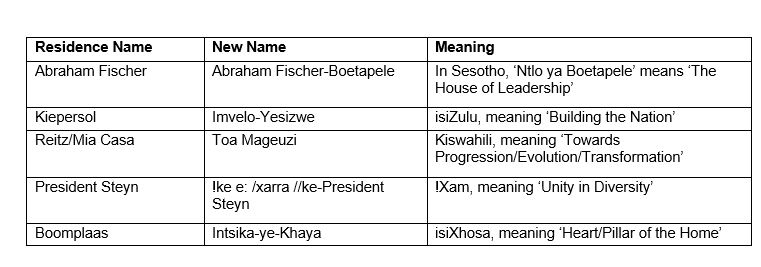During its meeting on 25 November 2022, the
Council of the University
of the Free State (UFS) unanimously approved the name changes of five residences on the Bloemfontein Campus.
The UFS
Institutional Transformation Plan (ITP) states that a transformed university in South Africa will be one that strives for social justice in everything it does. It will be an institution where its diverse people feel a sense of common purpose and where the symbols and spaces, systems
and daily practices all reflect a commitment to openness and engagement.
“It is in this context that the names and symbols of all 36 residences on the Bloemfontein Campus have been reviewed to ensure that the institutional culture and spaces contribute to an inclusive sense of belonging. The process was started in 2021
through the university’s Naming Committee,” said
Prof Francis Petersen,
UFS Rector and Vice-Chancellor.
Subsequently, a process was launched for the review and adjustment of the names of several residences on campus. The recommended name changes express the university’s commitment to courageously grapple with its shared past, present, and future.
They are informed by the (2020) Naming and Renaming Policy,
which “recognises that the names bestowed on its assets must sustain a harmonious balance between descriptive functions, the university’s origins, the rich history and heritage of the UFS, and the constitutionally democratic society it
is designed to serve”.
As such, the following name changes were approved by the UFS Council:

“The renaming process of the five residences included a variety of activities, all of which focused on building and implementing an engagement and consultation process with the various stakeholders and role player communities,” said Prof
Petersen.
During the renaming process, an important approach of the Naming Committee was to balance the social justice and multilingual agenda of the UFS. Therefore, the languages used in the renaming process reflect not only some of the languages spoken at the UFS (i.e., English, Sesotho, Afrikaans, and isiZulu), but also languages such as isiXhosa, Kiswahili and the use of a name that draws on the national motto in ways that recognise the Khoisan heritage of the Free State and South Africa.
“The renaming process is an important milestone for the UFS as it symbolises and celebrates the courage and vision of the university community for its commitment to transformation and for participating in a process which aims at producing a names
and symbols environment in which all can experience belonging,” said Prof Petersen.
During the Council meeting, the Naming Committee was thanked for the work done and for the balanced approach to the process of renaming the residences.